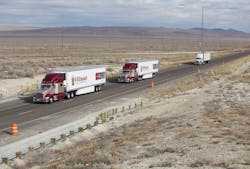Platooning trucks: A virtual reality
At least one Vehicle-to-Vehicle (V2V) technology firm is confident trucking will soon benefit from its system for virtually “platooning” trucks.
To platoon trucks is to efficiently operate them on a highway in close proximity-- one following after another at a pre-set distance via radar and wireless communication to form a virtual “road train.”
This operational concept leverages electronic controls and the automatic processing of shared data via V2V systems to improve highway safety and decrease both truck fuel consumption and greenhouse-gas emissions. It can also reduce stress on truckers by easing their workload at the wheel.
Menlo Park, CA-based Peloton Technology is the firm walking point for truck platooning. It’s developing a system that uses radar-based collision mitigation equipment and V2V communication technology to enable the close-in platooning of two tractor-trailers. Two at a time, though, is just for now.
Josh Switkes, PhD, Peloton’s CEO, told FleetOwner that implementing the one-two platooning of trucks by fleets where operationally feasible would improve highway safety by “electronically augmenting the skills of truck drivers.”
What’s more, he said platooning would greatly decrease fuel consumption as aerodynamic drag is slashed whenever two trucks are closely and consistently following each other going down the road.
The brains of the Peloton system is V2V technology that enables the following combination to respond to the deceleration/braking of the lead rig in a mere few hundredths of a second.
Switkes characterized that response as coming “dramatically faster” than any human driver could react.
On the other hand, he emphasized that the Peloton systems is not about replacing the driver, which is why the trucks’ operators always retains full control of steering.
In addition, Switkes pointed out that the various V2V and M2M systems interact to determine when platooning should be prevented due to poor weather or road conditions.
Also key to the Peloton system are video cameras. These are included to “increase driver awareness [of the road and the vehicles around him or her] and assist the driver with keeping in lane and staying alert,” explained Switkes.
He also noted that other on-board M2M-based gear, such as GPS and telematics systems, will “interact with fleet operational tools to optimize the routing and thus the pairing of the trucks.”
Back in November, Peloton engaged the North American Council for Freight Efficiency (NACFE) as an independent third-party outfit to help plan, execute and validate an unbiased fuel-efficiency test of the truck-platooning system.
Mike Roeth, NACFE executive director, has reported that the rigs supplied by truckload carrier CR England were electronically “connected” to remain 36 ft apart while operating at 64 mph on Interstate 80 west of Salt Lake City.
The platooned trucks were put through a modified SAE J1321 fuel-economy comparison test. The results, according to Roeth, showed a 10% fuel consumption reduction for the trailing tractor-trailer and a 4.5% reduction for the lead combination.
Truckers often take such painstaking real-world testing as proof of the pudding. What’s more, Switkes said that internal testing by Peloton of trucks platooned with less than 36 ft of separation chalked up even lower fuel-consumption numbers than those scored in the controlled test.
“Our platooning system is available now to fleets taking part in our piloting process,” advised Switkes. “And by late next year, we expect to have commercial systems on the market in quantity.”
Denny Mooney, Navistar International Corp.’s group vice president, Global Product Development told FleetOwner that platooning may well prove out beyond the two-truck concept that is Peloton’s current focus. His take is why view it as limited to a fleet here and there putting together platoons of two, or eventually a few, of their own trucks?
Rather, Mooney posits that “the trucking industry could develop and agree on common communication protocols so trucks can virtually ‘meet’ on the road and then elect to platoon over a certain distance or route. Platooning technology is here; it’s the practical details and regulatory issues that have to be worked out.
“Given that the Dept. of Energy has been supporting research and testing on this and that we at Navistar are involved in some projects,” Mooney continued, “I would expect to see truck platooning commercially available within five to ten years.”
Yves Provencher, director of Performance Innovation Transport (PIT), a Montreal-based truck engineering/research nonprofit, told FleetOwner that while platooning may be just around the corner, for it to succeed “fleets will have to create the business model to implement it cost-effectively.”
On the other hand, Provencher said fleet owners should “watch the development of platooning closely, as it’s no longer science fiction.
“And once it arrives,” he added, “the positive impact on safety and efficiency will compel government regulators to push for platooning’s adoption.”
